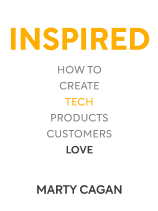

This article is an excerpt from the Shortform book guide to "Inspired" by Marty Cagan. Shortform has the world's best summaries and analyses of books you should be reading.
Like this article? Sign up for a free trial here .
Is there a better approach to product development than roadmapping? How is creating a product vision and strategy beneficial to development?
The process of roadmapping may be wasting your company’s time and resources. Instead, you should be using the product vision and strategy approach. The key benefit is that this approach is more flexible than a roadmap.
Here’s what you need to know about creating a product vision and a product strategy.
Say Goodbye to Roadmapping
There is a better approach than roadmapping that maintains the beneficial aspects of the roadmap (again, that employees are properly prioritizing their tasks and bosses are able to schedule around when they think tasks will be finished) while eliminating the weaknesses.
This alternative approach focuses on product vision and strategy. Each is essential to product development—product vision broadly allows companies to create a better understanding of their goals in building a product, and product strategy helps companies reach those goals. They are more flexible than a roadmap, which is stringent about deadlines and often comes from the top of an organization without input. We’ll now discuss vision and strategy in depth.
Vision
Product vision is the overall goal of the company (or, in a large company, a component of the company). It is something that can be achieved only far in the future—somewhere between two and 10 years. Here are 10 principles for creating a product vision:
- Ask why: Your product vision explains why you’re building your product and why you think it will succeed.
- Consider the problem rather than the solution: Be more curious about the problem you’re trying to solve than the possibility that a solution could make you rich or noteworthy.
- Think big: Again, it’s not a three-month horizon, it’s up to a decade. Don’t be afraid to dream.
- Disrupt your own company: If you’re not constantly reinventing products, another company will be and will take your market share or your goals.
- Inspire: Your vision should inspire your employees to be missionaries for the company. Build a vision that makes them excited to work for you.
- Consider trends: Similar to point #4, constantly monitor trends in your field, and adjust your plans accordingly.
- Be ready for changes: Even better than watching where the market is heading is predicting the market. Being on top of trends can help a company understand where trends might be going next. This way, you can be proactive rather than reactive.
- Be willing to change the details but not the vision: As we’ve outlined in the past few points, sometimes the details of your plan are going to change. But your overall vision should almost always stay the same.
- Understand that your vision is predicated on faith: If the vision you create isn’t a leap of faith, it’s not ambitious enough. It will likely take a few years to know if what you’re doing is working. This shouldn’t panic you.
- Spread the faith: Constantly communicate your vision inside and outside the company. Get people excited about your plan, and it’s more likely to come to fruition.
Strategy
Strategy is your plan to achieve the product vision. The product strategy can change more than the vision—it’s subject to fluctuations in the market, your team sticking together, or even where you’re competing geographically. There are four criteria for a sound product strategy:
- Focus your attention on a target: Pick one target and focus there before moving on. This could be a new geographic market or a new type of customer. If you’re trying to be all things to all people, you’re bound to fail.
- Align the business and the product: The business side of the company has to believe that the product will succeed, while the product-creation side of the company has to believe in the business strategy to make the product succeed. The marketing/sales strategy, in particular, needs to make sense to the product people, who understand the product the best.
- Consider the customers more than the competitors: Often, companies can get into a death spiral because they’re simply reacting to their competitors’ actions. Instead, focus on the customers first. This will be the best buttress against competitors.
- Communicate: Make sure that everyone within the company understands the product strategy.
Business Context
In addition to implementing vision and strategy, employees developing a product can do a better job if they understand the business context. This understanding informs their decision-making, and it helps them to better understand the value of their tasks. At tech companies in particular, business context has two components:
- The big picture. This is the company’s strategy and how its vision was developed. This gives employees an understanding of why they’re building the products they’re building.
- The objectives. This is, on a more granular level, what each team has to accomplish. Rather than giving teams a specific task, it’s better to give them an objective—like reducing onboarding time for a new customer from a few days to a few hours—and then letting the team figure out how to accomplish it.
By providing employees with an understanding of the company and freedom to work out the solutions to goals themselves, employees are better able to properly prioritize their tasks. Employees will know even better what to prioritize than in the roadmap scenario, because they’ll understand why their objective is important and then create a strategy to get it done themselves, rather than relying on a strategy from up top that might not be as efficient, because the people at the upper levels of the company might not have a good technical understanding of how to solve problems.
High-Integrity Commitments
Next, we’ll discuss the benefit of creating a realistic product development schedule or deadline.
Sometimes, especially in the later stages of product development when it’s obvious that customers like the idea, it is in the best interest of companies to set a due date. However, companies have to be sure that this will work—this means making what is called a high-integrity commitment, or a commitment that a team knows that it can fulfill because of research it has already done.
What’s important to note about these commitments is that, unlike roadmap-based commitments, product teams don’t make them too early. There isn’t an exact science to finding high-integrity commitments, but it’s about finding a good balance between executives and stakeholders and product managers and other workers. Once the product managers have figured out how to solve their problem, then it’s possible to set a soft due date on when they can deliver their work.

———End of Preview———
Like what you just read? Read the rest of the world's best book summary and analysis of Marty Cagan's "Inspired" at Shortform .
Here's what you'll find in our full Inspired summary :
- A two-step plan for creating and sustaining successful technology products
- Why product managers are so important in product development
- How to avoid some of the biggest pitfalls that most tech companies fall into






